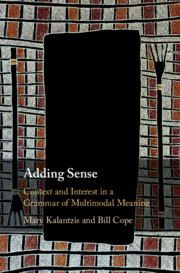Part 0 Meaning
Published online by Cambridge University Press: 22 April 2020
Summary
Making Sense addressed three meaning functions – reference, agency, and structure – in terms roughly parallel to Halliday’s three “metafunctions,” ideational, interpersonal, and textual. This companion volume “adds sense” by exploring two additional functions that we call context and interest. It sets out to create a framework with which to account for meaning that crosses the disciplinary paradigms of semiotics, linguistics (mainly pragmatics), the sociology of action, cultural and media studies, philosophy (ontology) and computer science (ontology again, or data structures). In this way, the book aims to provide a shared framework by means of which a range of practitioners will be able to work together, in education, communications, media, architecture, the arts, design, computing, and more. These disciplines and their related work practices have their own distinctive but mostly separate frameworks for understanding their respective domains of action. But all deal in their daily practices with meanings in their profound multimodality.
- Type
- Chapter
- Information
- Adding SenseContext and Interest in a Grammar of Multimodal Meaning, pp. 1 - 20Publisher: Cambridge University PressPrint publication year: 2020



